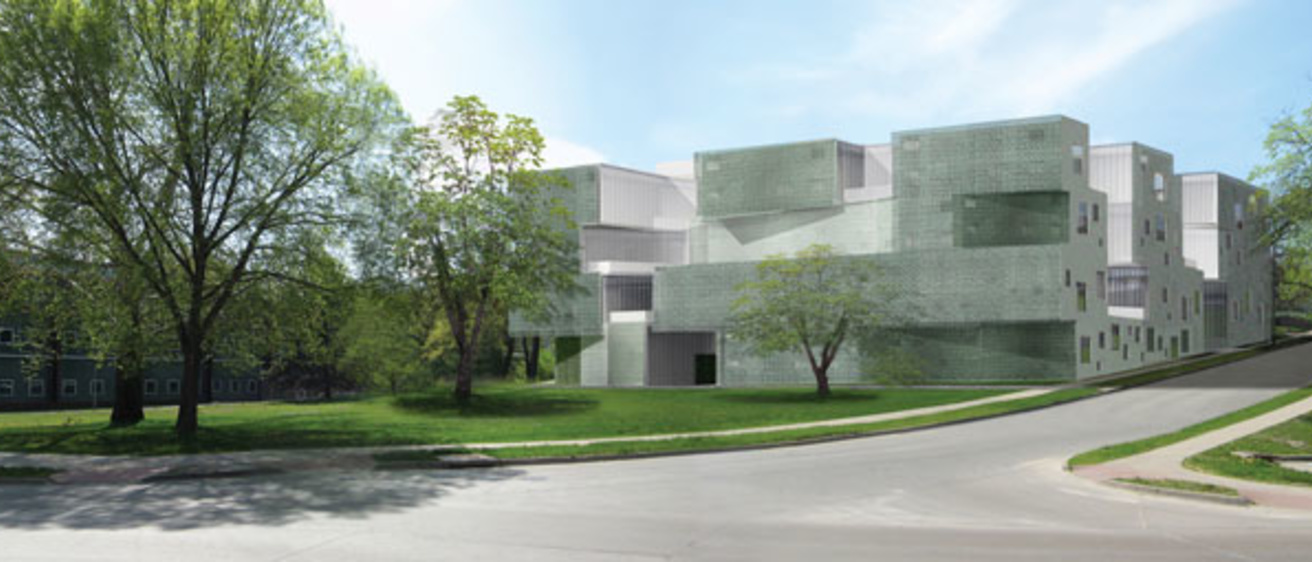Just weeks after the 2008 flood ravaged the arts campus, the University of Iowa School of Art and Art History’s numerous studio arts disciplines found themselves together beneath one roof. Although this situation of solidarity is one that creates community, it was taking place in a facility most recently used to sell nails, light bulbs, power tools, and everything else one might need to improve house and home.
The collaborative atmosphere forged at Studio Arts (the former Menards building on Highway 1 in Iowa City) will soon be found in a state-of-the-art facility—an exciting prospect for students and faculty alike.
“Being together in Studio Arts has reinforced the idea that students and faculty enjoy being able to walk around the corner and see what other people are doing. It enhances the production of art to be around the production of art,” says Steve McGuire, professor of 3-D design and coordinator of the studio division. “We will take that mindset into the new building, where the classrooms, the labs, the prototyping studios, they’ll be among the best facilities of their kind in North America.
“That’s pretty cool.”
The new facility, which will be situated adjacent to and northwest of Art Building West, will contain 126,000 square feet of loft-like space for the studio arts departments. To hear Steven Holl Architects describe it, “While Art Building West is horizontally porous and of planar composition, the new building will be vertically porous and volumetrically composed.”
In other words, natural light will fill the building through “light wells” strategically placed in the building. People will have visual lines of sight into the production facilities from a number of places within the building: as one travels through the building, that person will be able to see people producing art. “You can’t do that now at Studio Arts; you can’t do that in most art buildings,” McGuire says. “You will be able to do that in our new building.”
Related:
Read about the arts at Iowa, past and future, and look for previews of new School of Music and Hancher facilities in Iowa Now this week.
Not only will the new building house premier equipment in a collaborative space, it will give the studio arts programs a huge boost in terms of connectivity to the rest of campus—rekindling an advantage provided by arts programs at a strong public university.
“I talk to parents of prospective students, and they often ask, ‘What’s the difference between a university and an art school?’” McGuire says. “Within a university, the production of art is situated within a more diverse knowledge base. Students have a curriculum with greater depth and breadth, and that impacts their creative production.
“From a School of Art and Art History perspective, it will be convenient to be next to Art Building West. From a holistic view, the proximity to the main campus will be critical to students’ education.”
"If you’re a student or faculty member, and you know you’re walking into a room that is the best of its kind, it inspires you to pursue excellent work. Our building will have that kind of facilities."— Steve McGuire
Life in Studio Arts has improved some aspects of the program. One in particular: the sharing of equipment and facilities.
“In the old building, we did not share those things like we needed to,” McGuire says. “Studio Arts forced us to do that. For instance, we now have a wood shop rather than scattered pieces of equipment throughout the curriculum. Therefore, students are trained to use the wood shop as soon as they take their first class. It has brought a new level of safety to the program in the process, and we’ll bring this practice to the new building.”
Studio arts disciplines will remain independent, but the space and equipment in the new building will be shared. “We will have the flexibility to move throughout the new building, so any one class can take advantage of different processes,” McGuire says.
While Studio Arts provided the school with a home during this period of recovery and renewal—and allowed for a sense of identity the way that buildings clustered around each other don’t necessarily do—the move to the new home is surrounded by anticipation.
“I’m proud of the fact that students and faculty have made Studio Arts work,” says McGuire. “It’s novel in terms of the school’s history; people will look back on it fondly. But the collaborative atmosphere created here will move with us to the new building.”
And while the new facility will not be completed until 2016, McGuire and others in the School of Art and Art History felt certain it would be built from the moment the floodwater receded in 2008.
“The level of commitment was obvious from the first minute,” McGuire says. “A few days after we were flooded, I was involved in finding a location for the program. Even in that moment, the situation was approached as temporary. When people jokingly, or with a sense of fondness, said, ‘Can’t we transform Menards into what we need?’ the answer was, ‘No, we’re going to make something great.’”
